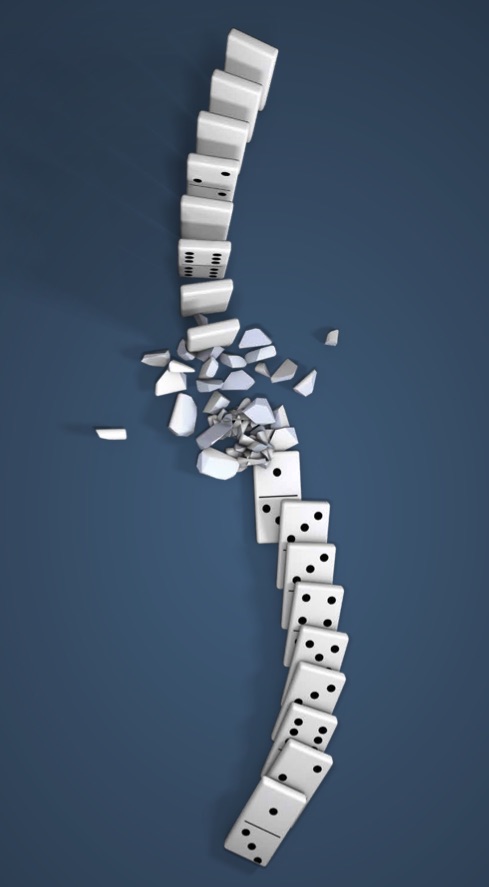Don’t miss the signs of a breaking spine
Up to 70 percent of vertebral fractures don’t come to clinical attention.
 Osteoporosis, a disease which causes bones to become weak and fragile, is the cause of broken bones in approximately one in three women and one in five men aged over 50 worldwide.
Osteoporosis, a disease which causes bones to become weak and fragile, is the cause of broken bones in approximately one in three women and one in five men aged over 50 worldwide.
Spine (or ‘vertebral’) fractures are the most common osteoporotic fractures – with one new fracture estimated to occur every 22 seconds worldwide. Yet although they are a major cause of pain and long-term disability, up to 70 percent of vertebral fractures don’t come to clinical attention.
Professor Cyrus Cooper, president of the International Osteoporosis Foundation (IOF), explained: “Patients with sudden back pain are often simply prescribed painkillers and not properly assessed and treated for the underlying cause. Yet without preventive treatment, one spine fracture can initiate a cascade of more broken bones, which in turn lead to long-term pain and disability.”
To mark World Osteoporosis Day which was on October 20, IOF urges particularly those over the age of 50 to be on the alert for three signs of possible spine fractures – sudden, severe back pain in the mid or lower spine; height loss of more than three centimetres (just over one inch); or stooped back.
Spine fractures most commonly occur near the waistline, or slightly above it (mid-chest) or below it (lower back). The pain is usually there all the time, but often gets worse with movement, particularly when changing positions.
If you suspect you could have vertebral fractures, be proactive in seeking help. Don’t just assume that your sudden back pain is due to arthritis, muscle strain or other causes – ask for a spine X-ray and get checked for osteoporosis. Imaging tests will provide important information about your fracture and will help your doctor determine if your injury is new (acute) or older (chronic). X-rays are the most common way to diagnose a vertebral fracture. Dual energy X-ray Absorptiometry (DXA) scan with vertebral fracture assessment is also used for diagnosis.
Spine fractures due to osteoporosis are almost twice as common as other osteoporotic fractures and occur in 30 percent to 50 percent of people over the age of 50.
The serious, long-lasting effects of vertebral fractures can cheat you of your future – drastically reducing your quality of life and physical independence. This may include: Severe deformity (kyphosis, i.e. stooped back); acute and chronic back pain; difficulty in bending and rising, difficulty in daily activities such as dressing or climbing stairs; depression; increased number of bed days; breathing difficulties; and problems with digestion.
In fact, one in five women with a spine fracture will suffer another within 12 months, with serious impact on their quality of life. Anita, a patient from Sweden with a family history of osteoporosis, is a typical example. She sustained multiple spine fractures, with the third occurring when she had the flu and simply coughed. As a result, she has lost six centimetres in height, suffers from chronic pain, and had to give up her beloved job as a nurse.
Fractures due to osteoporosis also represent an enormous burden to healthcare systems and costs are predicted to rise markedly over the next few decades. If you have suffered a spine fracture, your doctor may recommend a number of ways to help relieve the pain and aid bone healing:
- Pain relief with anti-inflammatory and pain medications.
- Short-term bed rest in cases of severe pain (patients should begin moving around as soon as possible within the limits of their pain).
- A back brace during the few weeks of healing.
- Physiotherapy – exercises to improve posture, muscle strengthening.
- A falls prevention programme.
- Hydrotherapy.
For patients who suffer severe pain that does not respond to non-surgical treatment, procedures that strengthen the vertebrae such as kyphoplasty and vertebroplasty may be considered.
To mark World Osteoporosis Day, IOF has provided several new resources including the One-Minute Osteoporosis Risk Test to help adults identify their personal risk factors for osteoporosis and there is other information on osteoporosis at: www.worldosteoporosisday.org.
** The bone information above is from the IOF website.
(** PHOTO CREDIT: IOF)

0 Comments